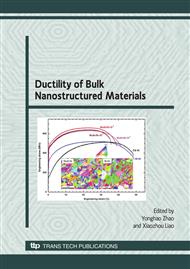p.321
p.333
p.341
p.353
p.365
p.373
p.383
p.393
p.411
Texture, Microstructure, and Ductility of Mg-Al-Zn Alloy after Equal Channel Angular Pressing
Abstract:
Equal channel angular pressing (ECAP) was used for grain refinement and texture modification in the initial pressed Mg-Al-Zn alloy to study the possibility to enhance the low-temperature deformability of the material. The effect of different ECAP regimes by routes A, C, and BC on the submicrocrystalline grain formation, texture evolution, and plasticity of the alloy have been investigated. The ECAP of the alloy results in the formation of ultrafine grained structure with a grain size of 0.8-3.5 µm independent of pressing routes and regimes. The ECAP also drastically changes the axial texture by splitting the initial texture characterized by a sharp basal component to several more scattered orientations. The degree of the orientation scattering depends on the ECAP regime and route. It is proposed to estimate the effect of the texture on the yield strength and plasticity of the alloy after ECAP through generalized Schmid factors. The comparable calculated and experimental results are obtained only for yield strength.
Info:
Periodical:
Pages:
365-372
Citation:
Online since:
November 2009
Price:
Сopyright:
© 2010 Trans Tech Publications Ltd. All Rights Reserved
Share:
Citation:


